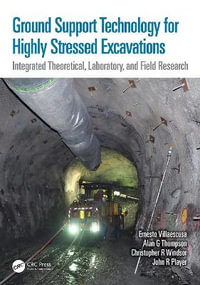
Disturbed Soil Properties and Geotechnical Design
By: Andrew Schofield
Hardcover | 24 November 2017 | Edition Number 2
At a Glance
Hardcover
$337.90
Aims to ship in 15 to 25 business days
When will this arrive by?
Enter delivery postcode to estimate
Disturbed Soil Properties and Geotechnical Design, Second edition describes the developments leading to the Original Cam Clay model, focusing on fundamentals of the shearing of soil. The first edition explained and illustrated fallacies in past work of engineering geologists, and laid groundwork for the understanding that should form the basis of modern geotechnical design.
With the changing environment, and the increasing size of construction projects, engineers now need a better understanding of ground behaviour to prevent future catastrophes such as the 1976 Teton Dam failure shown on the cover. The further additions in this book will help geotechnical engineers acquire this knowledge.
Disturbed Soil Properties and Geotechnical Design, Second edition
- provides an outline of the energy-based Cam-clay approach that can predict geotechnical deformations
- illustrates further fallacies in commonly used c-? Coulomb soil mechanics
- describes the use of centrifuge modelling in geotechnical design, based on examples from the last four decades
Once armed with the simple concepts of wet/weepy and dry/thirsty sides of the critical state line, readers will better understand if soil will tend to contract or dilate in drained shearing, and if pore pressures caused by undrained shearing will be positive or negative
Full of technical and personal insights, this is a rewarding book that forces the rethinking of modern geotechnical engineering. Much like the first edition, this book remains an invitation for the unconverted to re-examine the basic understanding of soil behaviour, and for the converted to ensure that the teaching, vocabulary and nomenclature used in describing strength models for soil, accurately reflect the underlying concepts.
Industry Reviews
This 182-page book is a useful reference for anyone interested in or gaining knowledge of the development of critical-state soil mechanics, a theory of plasticity which was initially jointly developed by Schofield in the 1950s. Topics covered range from simple planar sliding of soil to plastic design in geotechnical engineering. Historical coverage starts with Coulomb's theory of strength, through Taylor's recognition that interlocking between grains provides a component of strength, to Schofield's work on the Cam clay soil model and critical state concepts. Many other seminal geotechnical engineering contributions are discussed, critically reviewed and in some cases refuted. Limitations of the Cam clay model with regard to anisotropy, soil sensitivity and cyclic loading are acknowledged. The establishment and development of geotechnical centrifuge model testing in the UK is included together with mobilisable strength design, where calculations of the deformation of geotechnical systems are based on energy dissipation.
-- Colin Rawlings Jacobs/High Speed Two, UKISBN: 9780727761552
ISBN-10: 0727761552
Published: 24th November 2017
Format: Hardcover
Language: English
Number of Pages: 208
Audience: Professional and Scholarly
Publisher: Emerald Publishing Limited
Country of Publication: GB
Edition Number: 2
Edition Type: New edition
Dimensions (cm): 16.3 x 24.2 x 1.8
Weight (kg): 0.43
Shipping
| Standard Shipping | Express Shipping | |
|---|---|---|
| Metro postcodes: | $9.99 | $14.95 |
| Regional postcodes: | $9.99 | $14.95 |
| Rural postcodes: | $9.99 | $14.95 |
How to return your order
At Booktopia, we offer hassle-free returns in accordance with our returns policy. If you wish to return an item, please get in touch with Booktopia Customer Care.
Additional postage charges may be applicable.
Defective items
If there is a problem with any of the items received for your order then the Booktopia Customer Care team is ready to assist you.
For more info please visit our Help Centre.























